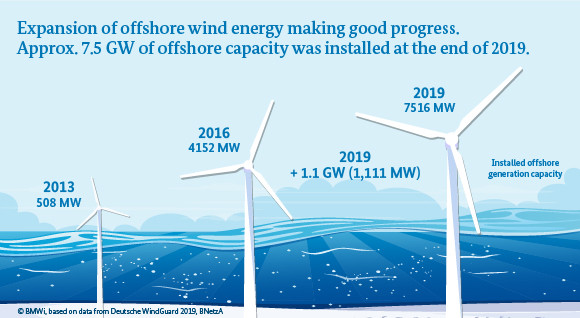More and more wind being harvested at sea
Wind energy generated at sea is becoming increasingly important. The installed capacity has risen considerably over the last few years. This is shown by a study by Deutsche WindGuard into the expansion of offshore wind energy in Germany in 2019.
 © BMWi, based on data from Deutsche WindGuard 2019, BNetzA
© BMWi, based on data from Deutsche WindGuard 2019, BNetzA
More than 160 new offshore wind energy installations have been working off our coasts since last year, delivering clean power to Germany. They have over 1,111 megawatts (MW) of installed capacity, giving a further boost to offshore wind energy.
As recently as 2013, the amount of installed offshore capacity stood at 508 MW, so the rise since then has been steep. The development shows that electricity from offshore wind energy is becoming more and more important for the energy transition. By 2016, offshore capacity had already risen to 4,152 MW, and the figure for 2019 was 7,516 MW.
Experts are happy with the new-build of roughly 1.1 gigawatts (GW) in installed capacity: it was in line with their expectations. This means that most of the 7.7 GW of offshore capacity which is allowed to be connected to the grid in 2020 according to the Energy Industry Act has been installed. Some of the installations were still under construction or had yet to feed any electricity into the grid at the end of 2019.
From 2022, further projects which were given the go-ahead in 2017 and 2018 will come on stream. In its Climate Action Programme, the Federal Government has decided to raise the current expansion target of 15 GW of offshore wind energy to 20 GW by 2030.
Overall, this meant that more favourable weather conditions in Germany in 2019 saw wind energy generate more electricity than any other source of energy in Germany’s energy mix for the first time. It displaced lignite from the top spot in Germany's ranking of electricity generation sources.

